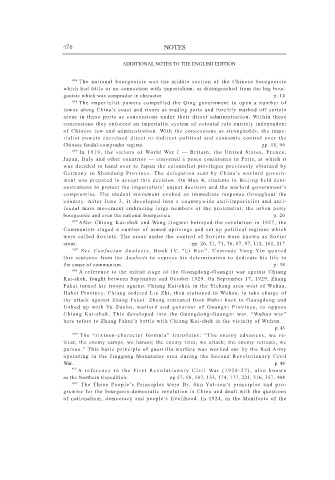Page 482 - SELECTED WORKS OF ZHOU ENLAI Volume I
P. 482
476 NOTES
ADDITIONAL NOTES TO THE ENGLISH EDITION
454 The national bourgeoisie was the middle section of the Chinese bourgeoisie
which had little or no connection with imperialism, as distinguished from the big bour-
geoisie which was comprador in character. p. 14
455 The imperialist powers compelled the Qing government to open a number of
towns along China’s coast and rivers as trading ports and forcibly marked off certain
areas in these ports as concessions under their direct administration. Within these
concessions they enforced an imperialist system of colonial rule entirely independent
of Chinese law and administration. With the concessions as strongholds, the impe-
rialist powers exercised direct or indirect political and economic control over the
Chinese feudal-comprador regime. pp. 18, 96
456 In 1919, the victors of World War I — Britain, the United States, France,
Japan, Italy and other countries — convened a peace conference in Paris, at which it
was decided to hand over to Japan the colonialist privileges previously obtained by
Germany in Shandong Province. The delegation sent by China’s warlord govern-
ment was prepared to accept this decision. On May 4, students in Beijing held dem-
onstrations to protest the imperialists’ unjust decision and the warlord government’s
compromise. The student movement evoked an immediate response throughout the
country. After June 3, it developed into a countrywide anti-imperialist and anti-
feudal mass movement embracing large numbers of the proletariat, the urban petty
bourgeoisie and even the national bourgeoisie. p. 20
457 After Chiang Kai-shek and Wang Jingwei betrayed the revolution in 1927, the
Communists staged a number of armed uprisings and set up political regimes which
were called Soviets. The areas under the control of Soviets were known as Soviet
areas. pp. 26, 51, 71, 76, 87, 97, 112, 161, 217
4 58 Se e Conf uc i an A nal e c t s, Book IV, “ L i Re n” . Com ra de Ya ng Yi n quot e d
this sentence from the Analects to express his determination to dedicate his life to
the cause of communism. p. 38
459 A reference to the initial stage of the Guangdong-Guangxi war against Chiang
Kai-shek, fought between September and October 1929. On September 17, 1929, Zhang
Fakui turned his troops against Chiang Kai-shek in the Yichang area west of Wuhan,
Hubei Province. Chiang ordered Liu Zhi, then stationed in Wuhan, to take charge of
the attack against Zhang Fakui. Zhang retreated from Hubei back to Guangdong and
linked up with Yu Zuobo, warlord and governor of Guangxi Province, to oppose
Chiang Kai-shek. This developed into the Guangdong-Guangxi war. “Wuhan war”
here refers to Zhang Fakui’s battle with Chiang Kai-shek in the vicinity of Wuhan.
p. 43
460 The “sixteen-character formula” translates: “The enemy advances, we re-
treat; the enemy camps, we harass; the enemy tires, we attack; the enemy retreats, we
pursue.” This basic principle of guerrilla warfare was worked out by the Red Army
operating in the Jinggang Mountains area during the Second Revolutionary Civil
War. p. 48
461 A referenc e to t he Fi rst Re vol uti onary Civil War (1924-27), a lso known
as the Northern Expedition. pp.57, 58, 107, 133, 174, 177, 221, 316, 357, 404
462 The Three People’s Principles were Dr. Sun Yat-sen’s principles and pro-
gramme for the bourgeois-democratic revolution in China and dealt with the questions
of nationalism, democracy and people’s livelihood. In 1924, in the Manifesto of the

